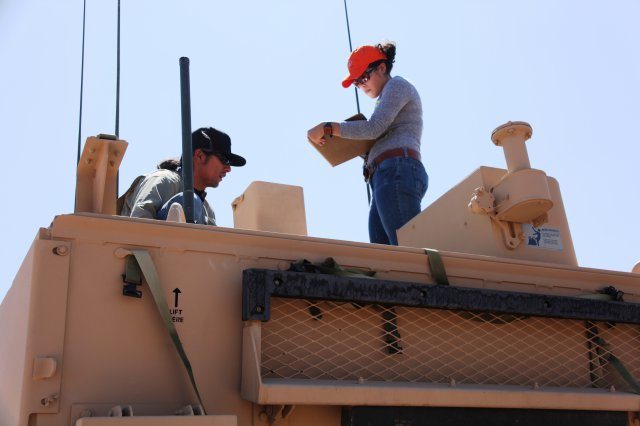The Army has completed safety release testing for a new fleet of networked vehicles, paving the way for Soldiers to begin training on them this month.
The Army Test and Evaluation Command determined that the five baseline designs for mine-resistant, ambush-protected vehicles, known as MRAPs, equipped with Capability Set 13, or CS 13, are suitable for new equipment training, which kicked off last week for the 3rd and 4th Brigade Combat Teams of the 10th Mountain Division. Capability Set 13 marks the first time the Army is delivering network systems as an integrated communications package that spans the entire brigade combat team formation, connecting the static tactical operations center to the commander on-the-move to the dismounted Soldier.
Inside MRAPs configured with components of CS 13, commanders will be able to exchange information and execute mission command using mobile communications technologies, rather than having to rely on a fixed infrastructure. To demonstrate that the vehicles are safe and functional to operate in theater, the Army is conducting a rigorous series of tests, the first of which concluded last month at ATEC’s Aberdeen Test Center, or ATC.
“As the Army moves toward smartly integrating and delivering Capability Sets, we also need to smartly test the integrated platforms within the context of the network,” said Robert Puhalla, synchronized fielding test lead, Army System of Systems Integration, or SoSI Directorate. “The Capability Set 13 testing takes advantage of previous efforts from Lab Based Risk Reduction and Network Integration Evaluations to ensure a thorough check-out prior to fielding.”
The safety release testing for CS 13 vehicles focused on two main categories: human factors and electromagnetic interference. During the human factors phase, test personnel conducted ingress/egress drills for various scenarios, such as evacuating a vehicle due to casualties. The testers donned full combat gear to ensure they could access and operate CS 13 system controls wearing different sets of gloves, including extreme weather arctic mittens, cold weather mittens with isolated trigger finger and protective gloves used on nuclear, chemical and biological missions.
The human factors testing produced valuable feedback regarding safety and function of the integrated CS 13 components, and led to some subtle design adjustments to improve accessibility. During the electro-magnetic interference, or EMI phase, engineers created “worst case configurations” that push the systems to their limit, such as transmitting voice and data simultaneously via the Warfighter Information Network-Tactical — known as the WIN-T Increment 2 — network backbone and several radios, in addition to raising and lowering the vehicles’ weapon systems. Under these conditions, testers can determine whether the radiation and interaction between the various systems and antennas will harm Soldiers.
“We’ve tested WIN-T on many High Mobility Multipurpose Wheeled Vehicle configurations, and have tested numerous military radios, but now the capability set combines WIN-T, additional radios, and the digital backbone all integrated on a MRAP All-Terrain Vehicle,” said Michael Geiger, the EMI Test Facility manager at ATC who oversaw the EMI testing. “There is a new level of complexity on these platforms, and there is a lot of value in understanding how everything works as a system to conduct a quality test.”
Running the tests at Aberdeen Proving Ground put testers in close proximity with the Army’s network experts, including project managers for Capability Set 13 systems and personnel from the Communications-Electronics Research, Development and Engineering Center, or CERDEC, also based at APG. CERDEC certified the network configurations prior to testing, while the PMs provide subject-matter expertise to quickly troubleshoot issues that arise.
The safety release testing cleared the way for Soldiers at Fort Drum, N.Y., and Fort Polk, La., to begin new equipment training. Following safety release, the Army is also conducting safety confirmation and network verification testing through December. Safety confirmation, also conducted at APG, clears the vehicles for use in theater. Network verification, which will take place at Fort Dix, N.J., pairs the vehicles with other CS 13 components and runs them through operational threads to validate the network configurations specific to the 10th Mountain Division.
“The network verification event will help ensure the CS 13 platforms coming off the production line operate and function as a fully integrated system of systems, as intended,” Puhalla said.
These final tests come on top of the Army’s NIEs, a series of rigorous field exercises leveraging 3,800 Soldiers of the 2nd Brigade, 1st Armored Division, executing realistic mission threads in the punishing terrain of White Sands Missile Range, N.M. The NIEs validated the CS 13 network, and also produced Soldier feedback that was incorporated into CS 13 vehicle designs.
The Army also conducted extensive Lab Based Risk Reduction activities at APG, in order to validate system functionality, interoperability, all configuration settings and mission threads prior to the NIE field exercises.










